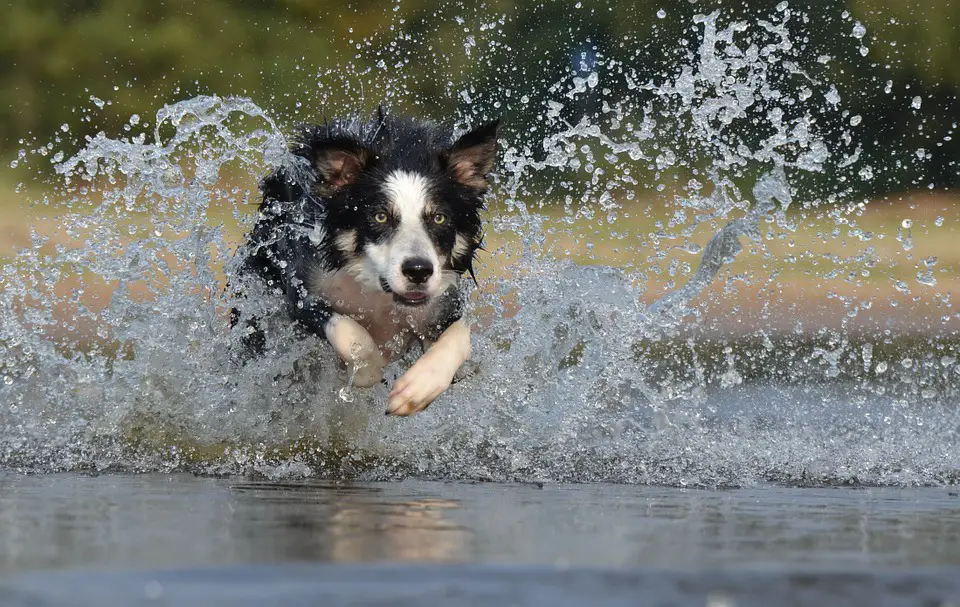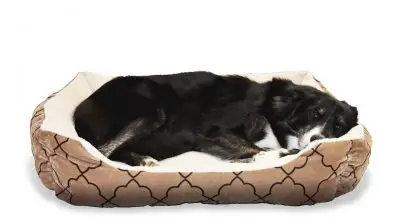Although Border Collies are extremely energetic, they take to crate training extremely well. They are able to see their crates as a place of sanctuary and will go there to rest after a strenuous day. For optimum results, you must sufficiently introduce the crate to your pet Border Collie. However, they can be suspicious of new experiences, so it is critical to go slowly in your Border collie crate training. Keep it positive always. As your dog catches onto your enthusiasm, they will quickly adjust to their crate.
Optimal crate size for border collies

Many owners utilize a 36-inch model crate, but the 42-inch size is roomy and can work optimally for your Border collie.
Some owners prefer to have the same crate from puppyhood to adult years. Because of this, they will select wire models with a removable divider. It allows you to expand slowly as your puppy grows. At this point, you might be wondering when your Border collie is considered adults? In some cases, border collies will reach their full adult size in just two years. The divider in the crate can be moved incrementally during their first year of life.
The following are some awesome materials that can be utilized as a crate for your border collie:
- Polyester
- Wood
- Plastic
However, a critical difference when it comes to these models is they do not have dividers. If you select any of these crates, you must start small and be ready to size up as your dog grows.
Ways to crate train your border collie
Make the crate as comfortable as possible
Although border the collies are considered farm dogs, they do love to be pampered. Some owners will observe that their dogs adore having a soft pillow as well as nice blankets to rest on. But it is not always this way. Throughout their puppy years, it is sufficient for a Border collie to only have a small crate pad inside to rest upon. It is critical because it keeps them from chewing and ripping off the beds and messing up the fluffy filling. This can prove to be a taxing cleanup challenge.
When your pups are still tiny, start with a pad to make the space comfortable as well as warm. As they start to grow, you can move on to providing them with plush bedding or pillows as well as blankets that they will like. If you observe that your dog is shredding the fabric, then switch to durable mat materials instead.
Add some coverings
Dogs like to feel that their crate is really a warm nook and Border collies are not an exception. It is possible for you to transform all the different crate models into something they like by providing a cover at the top. To keep things ultra-simple, utilize a dark sheet as well as a lightweight blanket.
For optimum fit, you can find covers that are purpose fit and can tightly hug all 3 sides of the crate. On the front side, these covers can be rolled up and tied into place until you need to put them down firmly. You can even choose blankets that have windows on every side if you so wish.
Prior to crate training, a Border collie keep in mind to take off their tags and collars. It is a must that they never wear a collar or harness inside that small space since it can get caught on the wirings as well as the sides. If you are anxious about something happening if they get loose and escape, make sure your pup is microchipped for effortless identification.
Make it fun

Even the comfiest crate can cause boredom to a Border collie. To level up the fun, jazz it up a bit and provide them a couple of enjoyable toys to play with. However, keep in mind that not any toy will work. Many will require supervision to keep your dog safe.
The safest toys to provide your dog in their crates would be made from tough and resilient rubber materials. These brands are made by Kong as well as West paw. The majority of toys made by these brands allow you to stuff them with yummy treats and do something similar. Freeze the toy for hours of fun. If your Border collie is a heavy chewer, the toys may not be a good option.
Treats are helpful as well
When training you dog, it is simply not the time to be stingy in providing treats. When you give your dog sufficient snacks, you can quickly connect the crate training with awesome rewards. Once they make that awesome connection, they will head into their crate upon request and perhaps even on their own will.
Whether it is by your request or on their own, keep the treats ready in the early days of crate training. After some time, you can slowly transition to praising them and save the treats for their newest tricks and feats.
Start playing
Before you can have any hopes of successfully training a Border collie, you must expend their energy. If you do not, they will become a lightning ball of intense energy that makes it a challenge to get anything accomplished. Play and run with your border collie at the beginning of every crate training to get ready for some training fun in the crate.
Repeat the procedure again
Just one run in a single day simply does not cut it for Border collies of every age. Border collies are super energetic, and they want to run on the yard over and over. To get the energy out of their minds and body, you can benefit from a brief 10 to 15 minutes of play prior to every crate training session. Plan on working with a crate up to 4 times a day to get your pup used to the training.
Ignore the whining
Border collies enjoy being around people and are also quite willing to let you know what’s on their minds and how they are feeling. Because of this, it is critical to ignore their whining since they will provide you some knowledge of their discontent the moment that the door of the crate closes. Because of this, it is critical that you walk away or stay silent, so you do not encourage their whining.
It would help if you threw tons of parties
One critical thing to know about Border collies is that they love parties. When you suddenly burst into a happy dance and provide them with enough praises, you give them enough reason to repeat the expected behavior. Please take advantage of their party animal attitude and get your tap shoes polished before you open that crate door. As you open the door, shower them with enough praise and let them know that their quiet resting is much appreciated.
Make sure to practice crate training in the daytime

Repetition is the key to successful training a Border collie. You must engage in daytime crate training at least four times a day to help them know how to behave while they rest inside.
To start, simply introduce them to the crate with the door opened. Please provide them with treats and sufficient praise each time they go inside, whether it is requested or done by their own will.
Once they are comfortable going inside and outside of the crate, ask your puppy to enter the den and close the door behind him. Please provide them with treats and cover the top and sides. Sit quietly beside them near the crate for a couple of minutes. Only open the enclosure when they start whining to avoid rewarding their whining. Increase the of time they will spend inside the crate until the 15-minute limit.
At this point, it will be time to leave them inside their crate while you walk into another area of the house. Limit the duration to 5 minutes stretches and then increase it once again. Remember to always provide treats and praise to reinforce the behavior desired.
Once you have reached 15 minutes of calm resting, the final phase of the training will begin. At this point, put your Border collie in the enclosure crate, then go outside for a few minutes. Provide them with sufficient rewards for an awesome job that is well done. You will be sending a message about behaving in a good way in their den.
Make sure to play awesome crate games
In some cases, dogs will not take crate training right away. To ease your dog’s distress, you may want to introduce games that will turn the space into something that is fun.
First off, you can start by providing them with high-value treats such as roast chicken. You can place a few pieces of roast chicken on the crate. Your dog will be inspired to take a look. Your dog might even dart in the crate right away to win the game and get additional treats. Within a couple of rounds of the game, your dog will be willingly entering the space but might still want to leave.
If your dog is toy-driven, you can move on to integrating the crate into your fetch game. You can randomly toss their toys into the crate, which will encourage them to dart inside and grab the toy. Afterward, treats will be rewarded for their bravery which will further help ease their worries with the crate. In time your dog will willingly enter the space upon request.
Your final game should bring obedience training into the mix and focus from the crate on to different tasks. After requiring your dog to go inside a crate, probably asked them to sit. Then reward them with something huge if they are still in that space will help them show that it was a big deal.
Slowly increase the time
if your dog manages to reach the 15 to 20-minute limit, training might seem to have arrived at a standstill. Keep up the training by increasing the time by 15 minutes intervals to slowly get your pup accustomed to staying in the crate.
Work up to having your pup in the crate for up to 4 hours in each session. After reaching the 3-month mark, puppies need to go out every 4 hours which helps train them with housebreaking.
It is critical to limit their total time inside to under 8 hours across the course of the day and night. To accomplish this feat, you might need to hire someone to look after your dog if you are working. You could get a kennel for the outdoors for your dog to run around while you are away from home.
Once you have housetrained your border collie and they are already past the destructive puppy stage of life, you can switch them out of their dense. However, you can still transition them back in from time to time if the situation warrants it.
Be flexible during nighttime
Keep in mind that until your puppy has gotten used to the crate, the nighttime hours may prove to be a huge challenge. It is critical for Border Collie puppies to go out every hour or 2 hours at first if taken at home at eight weeks.
Overall it is best to do what seems right for your individual puppy. It is critical to get through the first two months. After this, make changes that get their behavior disciplined which is effortless since border collies are fast learners.
Make sure to always keep it positive
With every stage of training a border collie, you need to always keep it positive. These dogs are super sensitive to how their owners are feeling. It is critical you keep your spirits up and throw them a party when your pup is showing progress and accepting their new crate.
Make sure to invest some time to help your Border collie enjoy that space, and your offers will also be rewarded. The crate will serve as a safe space for your Border collie whenever you need to be away from the house or get a bit of sleep. You can then rest assured that your Border collie is in a secured place and comfortable until you wake up or return to your home.
Final thoughts
Border collies are an amazing dog. It is a unique breed that can be your companion in every imaginable physical activity since they have such high energy levels. However, it is critical that just like any other dog, they must be crate trained and housebroken. You must know border collie crate training techniques. It minimizes the hassles and headaches you will encounter as a dog owner. Although you love your Border collie, it is critical that they follow you and consider you the boss.

